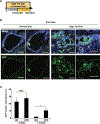Obesity Suppresses Cell-Competition-Mediated Apical Elimination of RasV12-Transformed Cells from Epithelial Tissues
- PMID: 29694905
- PMCID: PMC6314181
- DOI: 10.1016/j.celrep.2018.03.104
Obesity Suppresses Cell-Competition-Mediated Apical Elimination of RasV12-Transformed Cells from Epithelial Tissues
Abstract
Recent studies have revealed that newly emerging transformed cells are often eliminated from epithelial tissues via cell competition with the surrounding normal epithelial cells. This cancer preventive phenomenon is termed epithelial defense against cancer (EDAC). However, it remains largely unknown whether and how EDAC is diminished during carcinogenesis. In this study, using a cell competition mouse model, we show that high-fat diet (HFD) feeding substantially attenuates the frequency of apical elimination of RasV12-transformed cells from intestinal and pancreatic epithelia. This process involves both lipid metabolism and chronic inflammation. Furthermore, aspirin treatment significantly facilitates eradication of transformed cells from the epithelial tissues in HFD-fed mice. Thus, our work demonstrates that obesity can profoundly influence competitive interaction between normal and transformed cells, providing insights into cell competition and cancer preventive medicine.
Keywords: Aspirin; EDAC; RasV12; apical extrusion; cancer prevention; cell competition; chronic inflammation; lipid metabolism; obesity; pancrease.
Copyright © 2018 The Author(s). Published by Elsevier Inc. All rights reserved.
Conflict of interest statement
DECLARATION OF INTERESTS
The authors declare no competing interests.
Figures




References
-
- Bianchini F, Kaaks R, and Vainio H (2002). Overweight, obesity, and cancer risk. Lancet Oncol 3, 565–574. - PubMed
Publication types
MeSH terms
Substances
Grants and funding
LinkOut - more resources
Full Text Sources
Other Literature Sources
Medical
Molecular Biology Databases

